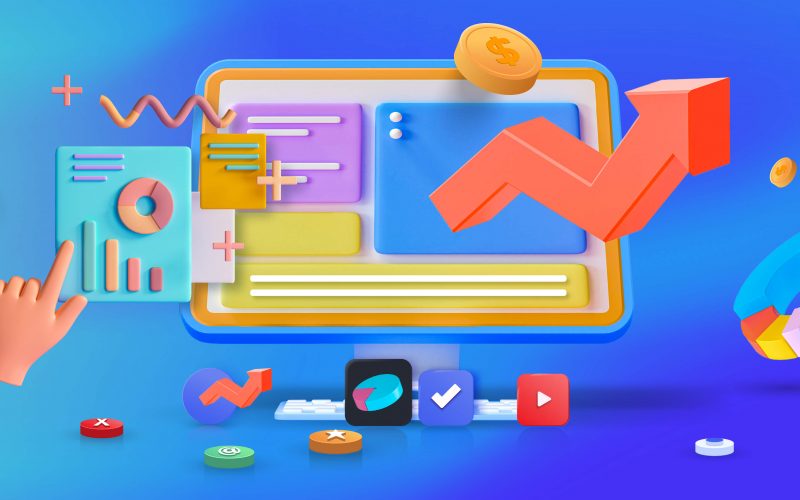For many people, forecasting sounds like something connected with weather prediction or fortune telling. Surprisingly, financial forecasting isn’t that far off. After all, businesses use it to predict their future performance, taking into consideration potential clouds on the horizon and thinking through steps to avoid getting into a thunderstorm. The difference is that businesses won’t need any crystal balls or magic potions to forecast – they’ll use their business data instead, which is an even more powerful tool.
What’s financial forecasting, and why does it matter for businesses? What does it take to create a financial forecast? Let’s look in detail at the answers to these and other important questions below.
Keep reading to learn about:
1. What is financial forecasting?
2. Why do businesses need financial forecasting?
3. How to create a financial forecast in three steps?
4. Do you need financial forecasting software?
What is financial forecasting?
In a more general meaning, financial forecasting stands for predicting or modeling a company’s future finances based on a thorough analysis of historical business data. Financial forecasting takes into account macroeconomic factors, such as inflation, consumer spending, employment rates, industry-specific trends, market competition, etc., that affect businesses either directly or indirectly.
If done right, financial forecasting is a powerful business tool that finance teams can use to analyze the current state of a company’s finances and estimate future incomes and expenses based on predicted demand for goods or services. Moreover, it helps to see what might happen should things change for the better or worse, and this way, plan for the worst-case scenarios in advance. With regards to business objectives, companies can create short- and long-term financial forecasts.
Financial forecasting is one of the top factors influencing informed decision-making. It greatly helps with budgeting, financial modeling, and business planning. In light of this, the accuracy of the data used to create financial forecasts plays a tremendously important role.
What are the major elements of financial forecasting?
As a rule, to create financial forecasts, a business would rely on three major financial statements, such as an income statement, a balance sheet, and a cash flow statement.
- An income statement — is the financial statement that shows all the business’ incomes and expenses during a given period, highlighting how the revenue turns into a company’s net income or net profit.
- A balance sheet — is a snapshot of a business’s finances at a given moment, showing a company’s assets, liabilities, and equity.
- A cash flow statement — is a financial statement that summarizes all the business’s inflows and outflows of cash for a given period.
The only difference is that they would be not common statements but pro forma financial statements.
What are pro forma financial statements?
Pro forma statements are financial statements built upon assumptions or hypothetical data rather than actual data. It means you fill in the data on revenues and expenses anticipated in the future.
These assumptions can be based on your previous financial data, where you find certain trends and apply them to create pro forma statements. For example, you’ve seen a 5% increase in the revenue from sales month over month for the last 6 months. So you can presume that you might have a total 15% increase in revenue at the end of the quarter and reflect this figure in your balance sheet and income statement forecast (a pro forma balance sheet and income statement), as well as cash flow forecasting for the upcoming quarter.
Quantitative and qualitative forecasting
With regards to what data is used to forecast, financial forecasts can be divided into two basic groups – quantitative and qualitative.
Quantitative financial forecasting implies that measurable historical data will be used to:
- Create pro forma statements (balance sheet, income and cash flow statements) using sales data from previous years and estimated expenses;
- Perform the time series analysis by seeking specific trends within the data for a certain period;
- Analyzing causal relationships: how changes in purchasing power, consumer confidence, interest rates, etc., affect your sales.
It’s worth noting that quantitative forecasts are a great option if you already have a considerable amount of data to analyze. Thus, they might not be as helpful for early stage businesses or startups.
Qualitative financial forecasting uses assumptions based on experience and understanding of the context and connection between events.
Qualitative financial forecasting tools and methods may include:
- Gathering expert opinion from sales and operation representatives or analyzing various scenarios that occurred in different time or places;
- Distributing a series of questionnaires for experts to fill in independently. This implies having several rounds, creating new sets of questions based on the results of the previous ones. The experts would need to reevaluate the answers given before. You’ll need to go on until you get a list of shared opinions (something that all or majority of the experts agree upon);
- Evaluating the possibility of various scenarios and the outcomes from each.
Quantitative financial forecasting can be a good option for businesses that lack financial historical data. Still, you need to bear in mind that some of the results can be biased, which can influence the accuracy of your data.
Historical and research-based forecasts
From the point of view of collecting the information necessary to create a financial forecast, there are two types of forecasts: historical and research-based.
Historical forecasting includes the information of your financial statements for the past years. Research-based forecasting means that you have to look at how the industry you work in has performed for the past years – everything counts, e.g. technologies, trends, analysis of your competitors, etc.
Needless to say that the best strategy is to find a balance between historical and research-based forecasting.
Financial modeling and projections vs. financial forecasting
Financial forecasting, financial modeling, and financial projections are often used interchangeably. This interchangeability stems from the vague difference between the terms and the fact that they often go hand in hand, supplementing each other to bring a more comprehensive overview of a business and its future performance.
Still, forecasts differ from financial projections and financial models in their purpose. Let’s take a look at a short comparison of all three.
Financial forecasts use the actual historical business data to find certain trends and, based on them, illustrate business performance in the upcoming period, provided nothing changes in the business operation.
Financial projections are predictions of a company’s future performance using historical data and anticipated (or planned) changes and events, as well as assumptions about changes in market conditions.
Financial models usually link together the forecasts and other data to preview how various scenarios, both best- and worst-case, might impact a business. It may include securing a loan, a drastic drop in sales due to a vendor going out of business, starting a new project, closing a deal, and more.
Long story short, forecasts help control finances and keep the business in good health, projections show the outcome of the planned events, and financial models help evaluate the possible impact of potential events before making important decisions.
Usually, when we speak about long-term financial forecasting, it’ll be a combination of the three: creating forecasts, projections, and financial models. When used together, they allow the management to assess risks and outcomes of starting a new project or any other important business activity anticipated in the future.
Budgeting vs. financial forecasting. What’s the difference?
Budgeting is one more term often confused with financial forecasting. At first glance, these two notions look very similar, and it’s not surprising that people get confused about them. Let’s compare budgeting and financial forecasting to see the difference.
Budgeting usually implies setting up financial goals a business aims to reach in the future. It includes estimated revenue, expenses, cash flows, and expected debt reduction. Businesses may fail to achieve some of the set budget targets due to some circumstances or changing market conditions. That’s why budgeting estimates may differ from the actual results a business sees at the end of the given period. A good rule of thumb is to analyze what caused the difference and reconsider budgets several times during a fiscal year to allow for changing business conditions.
The financial forecast, in turn, indicates if the company meets its budget goals and prospects for development in the future. It also helps managers estimate the number of upcoming deals and develop a business plan.
Why do businesses need financial forecasting?
As previously mentioned, financial forecasting helps to make informed decisions, as well as back critical business decisions with real numbers fetched from the business’s historical data. Let’s look at other virtues of regular financial forecasting.
- Control over a business’s cash flow: By analyzing your historical cash flow data, you can see when and how you usually get cash in and how it gets out of your business. This way, you can allocate it more wisely, investing in more profitable areas and cutting unnecessary expenses.
- Lowering risks of running out of cash (and out of business, consequently): Understanding your income and expenses trends helps you decide which spending you can decrease, cancel, or reschedule. Thus, you won’t lack the cash to pay your bills or salaries due to a large investment made at the wrong time.
- Scaling for growth: Regular financial forecasts can help you plan your future business income and set benchmarks to scale your performance to achieve your growth objectives.
- More efficient business planning: With a financial forecast, you can estimate your future cash needs and redistribute your cash more efficiently to prevent possible financial risks.
- Securing investment: Should you need to apply for funding from a bank or investors, you’ll require financial forecasts to show your capacity to repay the loan or your ability to grow to secure investors’ attention.
How to create a financial forecast in three steps
As a business owner, you need to know how to forecast. That doesn’t, however, mean that you must do it yourself. That’s especially true if you require short-term forecasting to control the state of finances and allocate cash and resources wiser. However, for more sophisticated long-term forecasting, and when forecasts are needed to secure funding, it’s recommended to turn to a specialist. It’s an investment that’ll pay off.
Financial forecasting may be more complex (if we speak about global business management) or a little simpler (for smaller businesses). But in its most general way, creating a business financial forecast includes three basic steps, such as fetching and accurately filling in historical data for a certain period, analyzing the data to find trends, and ultimately, creating pro forma financial statements using your findings (i.e estimated revenues and expenses)
| A side note: There are many forecasting templates for different industries on the market that a business can use, from simple to more sophisticated, both paid and free ones – you can choose what’ll suit you better. However, you can also create a forecast using an Excel file. Sometimes, it can be a better option, as it will be tailored to your particular needs. |
Let’s look at a simple financial forecasting flow to get a general idea of what it takes to forecast.
Step 1. Fetch historical data for the forecast from your financial statements
The first step is probably the hardest and most time-consuming one. It implies fetching historical data and organizing it conveniently. The biggest challenge here is ensuring the accuracy of the data that gets into the forecast. After all, your forecast is as good as the data that comes into it. This way, it’s critical that you have accurate data in accounting, where you usually generate financial statements.
Basically, you need to fill in an Excel file with the data from your income statement, balance sheet, and cash flow statement for a certain period – the past few months or even years. Usually, you fill in the first column with all the lines from your financial statement (or statements). Next, there will be a sector containing columns for each data point within your chosen period, such as for each previous month or a year (if you’re analyzing business data from several years back) in chronological order from the earliest to the latest.
Next to this sector, there will be the forecasting sector or the pro forma sector, where you’ll insert your projected incomes and expenses for the forecasting period (for instance, a quarter, half a year, a year, or several years ahead).
When it comes to organizing data in Excel, there are two ways you can do it: horizontally or vertically.
Horizontal organization implies creating separate tabs for each part of the forecast, such as the income statement data, balance sheet, cash flow, and the assumptions or trends you’ll use to forecast. The drawback of this method is that you have to switch between the tabs to copy the necessary data and formulas. Also, it can be harder to spot an error should you insert the wrong figure in one of the statements (in the line that corresponds to the similar one in another statement).
Vertical organization means that you fill all the data in a single tab, one part below the other. This way, you may have three sections – an income statement section, a balance sheet section, and a cash flow section. The left side of each section can be dedicated to the historical data, and the right side can be used to enter forecast data, thus creating pro forma statements. Below, you may have the trends analysis section (such as your sales growth percentage month over month, year over year, etc.)
Step 2. Analyze historical data to identify trends
Having all the data from financial statements for the period of interest put together in your file, you can proceed with analyzing different line items of financial statements to find specific trends that will allow you to make estimations for the future. Usually, they are the main line items, such as (if we speak about an income statement, for instance) sales revenue, COGS, gross profit, general expenses, depreciation, interest, and tax expenses.
Let’s imagine that we’re creating a forecast based on the sales revenue line (It’s the simplest example to illustrate the general idea. In real life, you might be using more variables to forecast.)
The simplest way to analyze your historical data on revenue is to calculate a year-over-year (YoY) or a month-over-month (MoM) change rate. This calculation displays (in per cents) how much your certain indicative (revenue, in our case) has grown (or decreased, but let’s not think about such a sad scenario). Based on this, you can estimate the growth rate for the upcoming months, or else you can calculate the average change rate and apply it to your forecast.
| A helpful tip. Excel allows you to visualize your data, so building charts may help you see the change in your sales over a given period. You’ll be able to determine the moments of increase and decrease in sales and compare them with the events that took place in those periods to understand how much they influenced the result. |
There are two ways you can calculate the MoM (or YoY) growth rate. You can use the one that you consider more convenient.
The first way implies dividing the current month’s value by the value of the prior month and then, subtracting 1 from the result.
Month-over-Month Growth = (Current Month Value / Prior Month Value) – 1
The second way of calculating the MoM change is to subtract the prior month’s value from the current month’s value and then divide it by the prior month’s value.
Month-over-Month Growth = (Current Month Value – Prior Month Value) / Prior Month Value
To get the percentage, you’ll need to multiply the result by 100.
A good practice is to create a forecasting section in your file (for example, below your financial statements data part) where you’ll fill in all the change rates for the months analyzed. This part may contain the lines for the revenue, gross profit, COGS, etc. – anything you want to identify the trends for. Just like the sections with the financial statements data, the forecasting section can comprise two parts: the historical change data part on the left, and the part for future projections on the right.
Step 3. Create a forecast, filling in pro forma statements
At the final step, you’ll need to fill in your forecasting part with the projected growth numbers for the upcoming months (depending on how far in the future you’re forecasting). These numbers can be the same (if you’re expecting to grow 5% every month, for example) or differ from month to month, depending on the trends you have found. For instance, you know that certain months are less profitable than others due to seasonality (if you sell skis, you can expect your sales to shrink during the summer months and increase closer to winter, for example).
Once you’re done with that, you can start creating your pro forma statements for the upcoming months applying your change rates to get the estimated values for your revenues and expenses. Here, the biggest challenge is to calculate the results and fill in all the lines in your pro forma financial statements correctly.
As mentioned above, it’s a simple example of forecasting. In real life, you’ll be analyzing more variables from different financial statements, such as a change in liabilities, equity, and more. Evidently, there will be more calculations and more effort and caution needed to fill everything in correctly. Moreover, you might want to include some planned changes (or scenarios that you’d like to see the impact on your business performance). This way, besides pure forecasting, you might proceed with projections and financial modeling. From the point of view of a business owner, this is a task that you won’t regret delegating to a professional, as knowing where the numbers come from can help understand the forecasts better.
What to learn more? Check our our article, which explains Accounts payable process!
Do you need financial forecasting software?
As you can see, financial forecasting requires significant effort. It’s just logical to think about whether financial forecasting software can help. Here’s where it gets tricky – financial forecasting software is a vague term, and the market offers a wide range of solutions for financial forecasting: from budgeting and business planning software to pre-set Excel forecasting templates. This way, it can be hard to decide what solution suits your business or whether you need it at all.
A good rule of thumb here is to look at the business software you’re already using. Many financial solutions, such as accounting software, can comprise features that allow for simple financial forecasting. However, they might not be enough to meet your needs.
What’s more, you can analyze your business needs and identify your requirements for forecasting software. These may include integration with your accounting software to fetch data from financial statements, automated data analysis, data visualization, and the ability to choose analytical methods. Should you need to create financial models, you may require the possibility to add certain variables to see the impact on your numbers. Sometimes you’d want to build your forecasts using all of your available data (not only financial statements).
You get the idea.
Financial forecasting: a wrap-up
Financial forecasts are a great tool a business can leverage to project future income and expenses and more accurately plan the budget necessary to cover business needs. And when it comes to making big business growth decisions, they must be data-driven. Here’s when financial forecasting will be of great help.
There’s an opinion that financial forecasting is more of a lottery where you cannot predict the actual outcome. It’s probably rooted in the lack of understanding of how big a part data quality plays in forecasting. But a financial forecast is as good as the data in the financial statements. Thus, it’s critical for a business to have accurate data in accounting. Synder Sync allows you to accurately record your sales in accounting so that your financial reports can always be correct.
Learn more about how Synder products can help your business — book a live demo to have your questions answered!

.png)





